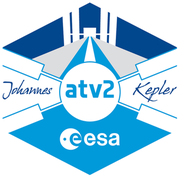 Johannes Kepler in orbit, prior to its rendezvous with the ISS | |
| Mission type | ISS resupply |
|---|---|
| Operator | European Space Agency |
| COSPAR ID | 2011-007A |
| SATCAT no. | 37368 |
| Mission duration | 124 days, 22 hours, 53 minutes |
| Spacecraft properties | |
| Spacecraft type | Automated Transfer Vehicle |
| Manufacturer | EADS Astrium Thales Alenia Space |
| Launch mass | 20,050 kilograms (44,200 lb) |
| Start of mission | |
| Launch date | 16 February 2011, 21:51 UTC |
| Rocket | Ariane 5ES |
| Launch site | Guiana, ELA-3 |
| Contractor | Arianespace |
| End of mission | |
| Disposal | Deorbited |
| Decay date | 21 June 2011, 20:44 UTC |
| Orbital parameters | |
| Reference system | Geocentric |
| Regime | Low Earth |
| Inclination | 51.6° |
| Docking with ISS | |
| Docking port | Zvezda Aft |
| Docking date | 24 February 2011, 15:59:19 UTC[1] |
| Undocking date | 20 June 2011, 15:46 UTC[2] |
| Time docked | 115 days, 23 hours, 46 minutes |
| Cargo | |
| Mass | 7,084 kg (15,618 lb) |
| Pressurised | 1,600 kg (3,500 lb) |
| Fuel | 5,384 kg (11,870 lb) |
| Gaseous | 100 kg (220 lb) |

| |
The Johannes Kepler ATV, or Automated Transfer Vehicle 2 (ATV-2), was an uncrewed cargo spacecraft built to resupply the International Space Station (ISS). It was launched on February 16, 2011 by the European Space Agency (ESA).[3] Johannes Kepler carried propellant, air and dry cargo weighing over 7,000 kilograms (15,000 lb),[4] and had a total mass of over 20,000 kilograms (44,000 lb),[5] making it, at the time, the heaviest payload launched by the ESA.[6] The second of five Automated Transfer Vehicle spacecraft, it was named after the 17th-century German astronomer Johannes Kepler.[7]
The ATV carried around five tons more cargo than Russia's Progress-M resupply spacecraft, and about 1.5 tons more than the Japanese HTV.[8] The ATV used 4,500 kilograms (9,900 lb) of fuel to boost the ISS's altitude from 350 to 400 km.[9]
Many of the supplies aboard the ATV were used for the Space Shuttle mission STS-133 and the ISS Expedition 26.[1] A Reentry Breakup Recorder was placed aboard the ATV before it undocked from the ISS on June 20,2011.[10] Johannes Kepler performed a destructive re-entry as intended on 21 June 2011, with its remains impacting the Pacific Ocean.
- ^ a b NASA Live TV broadcast. 24 February 2011. Retrieved 12 January 2013.
- ^ ESA ATV blog. Retrieved 11 June 2011.
- ^ Cite error: The named reference
16FebUTCESAwas invoked but never defined (see the help page). - ^ NASA's Consolidated Launch Schedule. Retrieved 22 March 2012.
- ^ Chris Gebhardt (15 February 2011). "Ariane 5 launches ATV-2 for journey to the ISS". NASASpaceflight.com. Retrieved 20 March 2011.
- ^ "Europe's ATV space ferry ready for launch". ESA. 3 February 2011. Retrieved 3 February 2011.
- ^ "Second ATV named after Johannes Kepler". ESA. 19 February 2009. Retrieved 16 July 2010.
- ^ ESA (January 2011). "INFORMATION KIT ATV Johannes Kepler" (PDF). ESA. Retrieved 26 June 2011.
- ^ Cite error: The named reference
nasawas invoked but never defined (see the help page). - ^ "Unique Aerospace Invention Ready For Debut". Space Travel.com. 29 March 2011. Retrieved 29 March 2011.